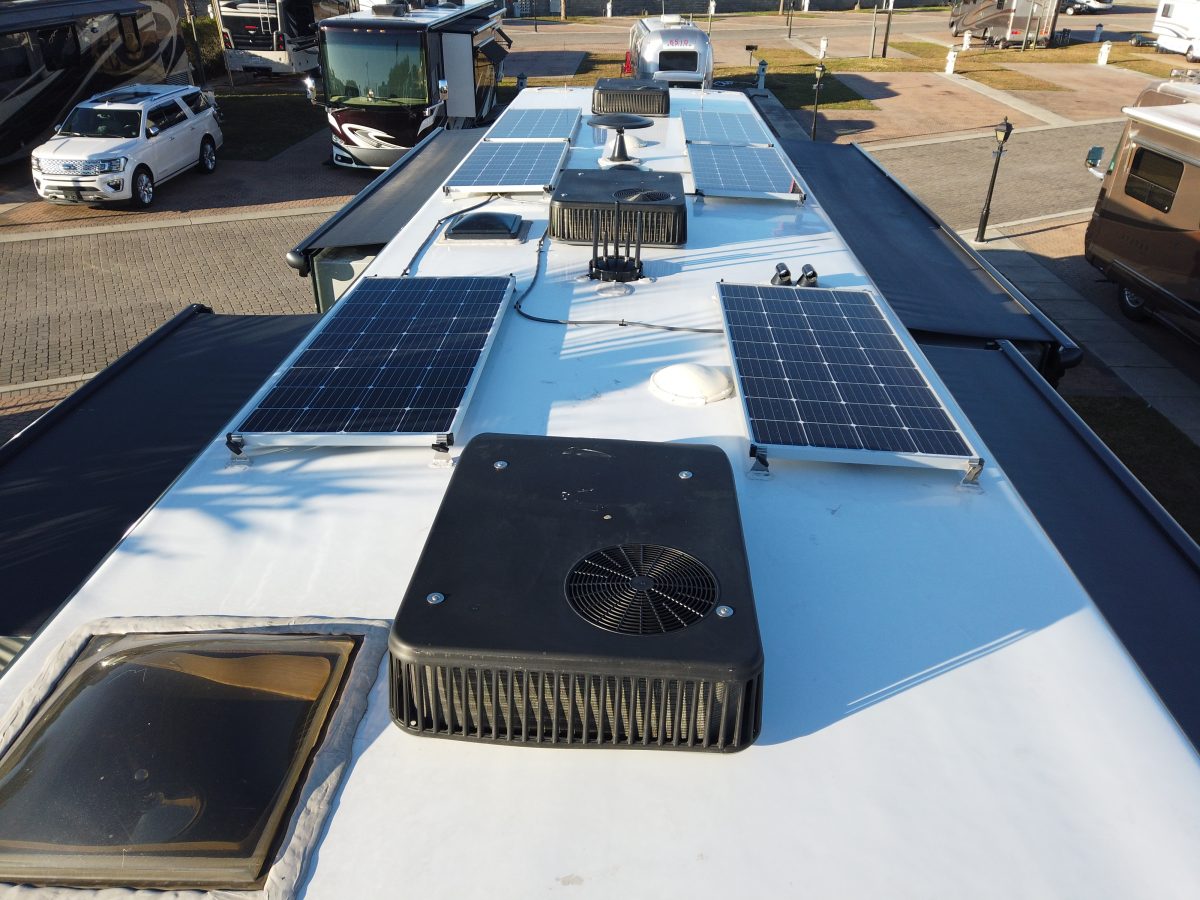Maintaining RV Solar System for Peak Performance: 2025 Guide

Learn how to maintain your RV solar system for peak performance. Discover essential cleaning, inspection, troubleshooting, and tips to keep your solar power efficient and reliable.
Introduction
An RV solar system is a fantastic investment that provides clean, off-grid power for your adventures. To ensure your system consistently delivers maximum efficiency and reliability, maintaining RV solar system for peak performance is crucial. Regular care and inspection can prevent costly repairs, extend the lifespan of your equipment, and keep your energy flowing smoothly wherever you travel.
In this guide, we cover essential maintenance tips—from cleaning and visual inspections to troubleshooting and upgrades—so you can keep your RV solar system in top shape year-round.
Why Maintenance Matters for RV Solar Systems

Maintaining RV Solar System
Solar panels and associated components operate in harsh environments—outdoors, exposed to dust, dirt, moisture, UV rays, and vibration from travel. Over time, these factors can reduce system performance and cause equipment issues if not addressed.
Maintaining your RV solar system is crucial
Maintaining your RV solar system is crucial for ensuring its longevity and efficiency, according to Rocksolar. By following a regular maintenance routine, you can maximize your solar panels’ energy output and avoid costly repairs down the line.
Here’s a breakdown of essential maintenance practices for your RV solar system:
1. Solar panel cleaning
- Frequency: Clean your solar panels regularly to remove dirt, dust, bird droppings, and other debris that can obstruct sunlight and reduce efficiency. The frequency depends on your location and environmental conditions.
- Method:
- Sweep first: Gently sweep off loose dirt with a soft brush or cloth.
- Wet cleaning: Use a soft brush or sponge with mild soap and water to clean the panel surface. Avoid abrasive cleaners or harsh chemicals.
- Rinse: Thoroughly rinse the panels with clean water to remove soap residue. You can use de-ionized water to prevent spotting.
- Avoid high-pressure washing: Excessive water pressure can damage the panels’ seals and internal components.
2. Inspecting panels for damage
- Routine Checks: Periodically inspect your solar panels for any signs of physical damage, such as cracks, scratches, or loose connections, which can impact performance.
- Prompt Repair: Address any damage promptly to prevent further complications or reduced efficiency.
3. Checking electrical connections and wiring
Regularly check all electrical connections between your solar panels, charge controller, and batteries to ensure they are secure and free of corrosion. Inspect the wiring for any signs of wear or damage and replace faulty components immediately. Also, inspect roof penetrations and mounting hardware, replacing sealant and ensuring secure fastening as needed.
4. Battery maintenance
Routine battery checks include looking for corrosion, leaks, or damage, and keeping terminals clean. Monitor battery voltage with a multimeter and, for lead-acid batteries, check and refill electrolyte levels with distilled water. Charge batteries regularly, especially during inactivity, and consider a battery maintainer. Replace batteries when performance declines significantly.
5. Inverter and charge controller maintenance
Install these components in a well-ventilated area away from direct sunlight. Periodically check for physical damage, corrosion, or loose connections. Ensure all connections are tight and keep firmware and software updated. Monitor performance using built-in or third-party tools.
6. System monitoring
Regularly monitor your system’s performance using available tools. Track power output, voltage, and any alerts to detect issues early. Review and adjust your energy consumption habits to optimize system usage.
7. Professional assistance
Seek a qualified technician for complex issues with components like the inverter, charge controller, or batteries, or for damaged panels.
Professional help is also recommended for system upgrades, expansions, or new installations. For electrical issues that pose a safety risk, always consult a professional immediately.
Implementing these maintenance practices will help your RV solar system continue to perform optimally, providing reliable power and protecting your investment.
- Ensures panels stay clean and able to absorb maximum sunlight.
- Prevents wiring and connections from corrosion or damage.
- Helps detect faults early before they worsen.
- Protects batteries from premature failure.
- Maximizes energy efficiency and system longevity.
Essential Maintenance Tasks for Your RV Solar System
1. Clean Your Solar Panels Regularly
- Frequency: Inspect and clean panels every 2-3 months, or more often if traveling in dusty or pollen-heavy environments.
- How:
- Use a soft cloth or sponge with warm water and mild soap.
- Avoid abrasive materials or harsh chemicals.
- Rinse with clean water and let air dry or gently wipe dry.
- Why: Dirt, dust, bird droppings, and grime reduce panel efficiency by blocking sunlight.
2. Inspect Wiring and Connections
- Frequency: Check wiring and connectors at least twice a year.
- What to Look For:
- Signs of fraying, cracks, or exposed wires.
- Loose or corroded connectors and terminals.
- Water ingress or damage from rodents.
- Action: Tighten loose connections, replace damaged wires, and clean corrosion using electrical contact cleaners. Protect exposed wires with conduit or protective sleeves.
3. Check Charge Controller and Battery Health
- Charge Controller: Verify the controller displays normal charging indicators and error-free operation. Clean dust off vents and display panels.
- Batteries:
- Check battery terminals for corrosion and clean if necessary.
- For flooded lead-acid batteries, regularly check and refill electrolyte levels with distilled water.
- Monitor battery voltage and state of charge to detect declining capacity early.
- Tip: Use a battery monitoring system for real-time status updates.
4. Examine Inverter and Other Electrical Components
- Inverter: Ensure the inverter runs quietly, with no strange noises or overheating. Keep it dust-free and well-ventilated.
- Fuses and Breakers: Test periodically to ensure they trip correctly and replace any blown fuses promptly.
Troubleshooting Common RV Solar System Issues
- Low Power Output:
- Check panel cleanliness first.
- Inspect shading from new roof obstructions like antennas or vents.
- Confirm correct wiring and controller function.
- Battery Not Charging:
- Test charge controller settings and wiring polarity.
- Check battery health and connections.
- Inverter Issues:
- Ensure correct wiring and ventilation.
- Check for overloads or faults with connected appliances.
Tips for Enhancing System Performance and Longevity
- Upgrade to MPPT Charge Controllers: More efficient controllers extract higher power from panels, especially in low light.
- Add More Panels or Batteries: Scale your system based on changing energy needs or longer off-grid stays.
- Use Solar Panel Covers or Shades: Protect panels when parked over extended periods but remember to clean frequently when in use.
- Maintain Roof Sealants: Ensure mounts and roof penetrations stay leak-proof to prevent damage.
Seasonal Maintenance Considerations
- Winter: Clear snow from panels promptly as snow blocks sunlight and adds weight. Check batteries more frequently for cold-weather effects.
- Summer: Regularly inspect wiring and components for heat damage or melting. Keep inverters and batteries in shaded, cool areas if possible.
Conclusion
Maintaining your RV solar system for peak performance is vital to enjoying uninterrupted, efficient power on your travels. Simple, regular tasks like cleaning panels, inspecting wiring, and monitoring battery health add years to your system’s life and reliability.
With proper care, your solar system will continue powering your adventures quietly, cleanly, and sustainably for many miles to come.
FAQ: Maintaining Your RV Solar System
Every 2-3 months or more frequently in dusty or pollen-heavy areas.
Faster loss of charge, lower voltage under load, swelling, or leaking.
Yes, with basic tools and knowledge. Professional help is recommended for battery servicing or complex electrical issues.
